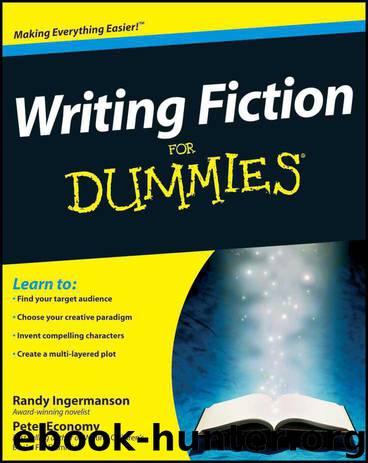Writing Fiction for Dummies by Peter Economy & Randy Ingermanson

Author:Peter Economy & Randy Ingermanson [Economy, Peter & Ingermanson, Randy]
Language: eng
Format: epub
Tags: Writing, Amazon.com
ISBN: 0470530707
Publisher: For Dummies
Published: 2009-01-01T15:00:00+00:00
Objective: Your reader needs to be able to visualize exactly what your character wants next.
Worthwhile: Your reader must believe the character would actually make this decision, based on her values.
Achievable: Your reader must believe that success really may be just a chapter away.
Difficult: Your reader must have some doubts that this decision will work.
At 3:00 a.m., your reader needs a reason to turn over the page instead of turning out the lights. A decision that's simple, objective, worthwhile, achievable, and difficult gives your reader that reason.
Notice that this decision sounds an awful lot like the goal of a proactive scene. That's exactly what a decision is — a choice to pursue a new goal.
Coming full circle with your scenes
A proactive scene starts a character out with a goal, hits him with loads of conflict, and then rocks him back with a setback. A reactive scene picks up immediately afterward, taking that character through an emotional reaction, then working him through an intellectual dilemma, and finally taking him to a decision — to pursue a new goal.
In theory, therefore, you can write a proactive scene and follow it up with a reactive scene and follow that with a new proactive scene, alternating forever. That's a fine theory, and it works often in practice but not always. Here are a couple of reasons you may not follow this strict alternation of proactive and reactive scenes in your fiction:
To pick up the pace of your story: Modern commercial fiction often blazes through the story at a gallop. In fast-action fiction, the proactive scenes run long, and the author may fly through the reactive scene in a paragraph of narrative summary. The author may even skip the reactive scene, leaving it to the reader to figure out what reaction, dilemma, and decision the POV character worked through.
Download
This site does not store any files on its server. We only index and link to content provided by other sites. Please contact the content providers to delete copyright contents if any and email us, we'll remove relevant links or contents immediately.
| Arts & Humanities | Health |
| Language Arts | Library Skills |
| Mathematics | Reading & Phonics |
| Science & Technology | Social Studies |
The Art of Coaching Workbook by Elena Aguilar(51081)
Trainspotting by Irvine Welsh(21573)
Twilight of the Idols With the Antichrist and Ecce Homo by Friedrich Nietzsche(18572)
Fangirl by Rainbow Rowell(9180)
Periodization Training for Sports by Tudor Bompa(8215)
Change Your Questions, Change Your Life by Marilee Adams(7689)
This Is How You Lose Her by Junot Diaz(6836)
Asking the Right Questions: A Guide to Critical Thinking by M. Neil Browne & Stuart M. Keeley(5712)
Grit by Angela Duckworth(5557)
Red Sparrow by Jason Matthews(5428)
Paper Towns by Green John(5141)
Room 212 by Kate Stewart(5073)
Ken Follett - World without end by Ken Follett(4686)
Housekeeping by Marilynne Robinson(4398)
The Sports Rules Book by Human Kinetics(4348)
Double Down (Diary of a Wimpy Kid Book 11) by Jeff Kinney(4244)
Papillon (English) by Henri Charrière(4229)
The Motorcycle Diaries by Ernesto Che Guevara(4054)
Exercise Technique Manual for Resistance Training by National Strength & Conditioning Association(4023)
